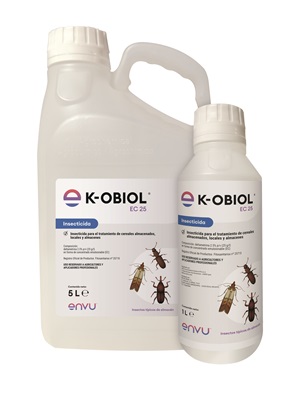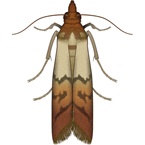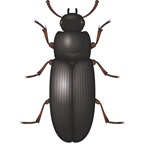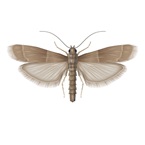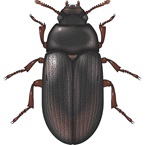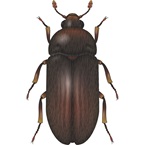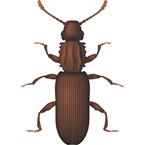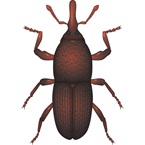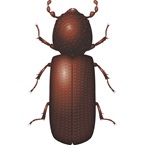Order: Lepidoptera (‘scale wings’)
Family: Pyralidae
Tropical Warehouse Moth:
12-18 mm wingspan
CHARACTERISTICS:
Two pairs of well developed membranous wings, with few cross veins; clothed with broad scales; generally suctorial mouthparts; metamorphosis complete with egg, larval, pupal and adult stages; larvae frequently have eight pairs of limbs.
SPECIES CHARACTERISTICS:
Tropical Warehouse Moth (Dried Currant Moth) (Ephestia cautella)
12-18mm wingspan; upper forewing: dull greybrown; straight dark inner band has broad pale band along inner edge; outer band is obscure.
AREAS WHERE FOUND:
Moths can be found in a variety of stored products. Some species are associated with goods of vegetable origin, to which they may be adapted with varying degrees of specificity, whilst others are associated with animal products - particularly textiles.
Tropical Warehouse Moth: A tropical or subtropical species which is frequently found on imported cargoes.
IMPORTANCE AS A PEST:
Moth larvae can cause considerable damage to stored goods by feeding or by contamination with their own products, e.g. webbing and frass. Adult insects are not responsible for damage as they either feed on liquid food and water or do not feed at all. The larval by-products, webbing and frass, are a particular problem. Webbing can entirely coat commodities and may be responsible for blocking machinery and ducts. The problem is exacerbated when webbing becomes mixed with frass, food and general debris.
Tropical Warehouse Moth
A particular problem in dried fruit and nuts, although this moth will attack cereals, oil seeds and chocolate products.
LIFE-CYCLE:
Larval development is greatly influenced by the environmental conditions of temperature and food supply. The larvae themselves are unique and readily identifiable: well-developed head; clearly segmented body; three thoracic segments, each bearing a pair of five jointed legs; ten abdominal segments: numbers 3-6 bear false feet (prolegs), the tips of which are equipped with crochets; segment ten bears one pair of claspers.
Tropical Warehouse Moth
Egg laying commences within 24 days of the adult's emergence and up to 350 eggs are laid during the first 4 days. These hatch 3-17 days later. The larvae are dirty white and may be tinged brown or have purple spots. At 25°C they will be fully grown in 25 days. The larvae do not diapause. Pupae develop in 12-17 days in the vicinity of food, and breeding is continuous. Where temperatures are low the moth overwinters as larvae.
CONTROL:
The method and timing of control measures against moths, depends upon the species involved. The larvae are frequently difficult to reach because they are concealed in foodstuffs or the fabric of buildings and may be obvious only when they migrate.
Assessment of infestations
Adhesive traps are used for trapping stored product moths. Attractant capsules containing a pheromone are attached to a sticky surface on which the moths are caught and which is partially protected from the environment. The trap is then suspended ca 2-3 m above the floor. They perform best in locations which are not dusty. Alternatively funnel traps may be used. These are usually constructed of plastic and incorporate a funnel system leading to a retaining chamber in which moths are trapped and killed using a toxicant strip, water or detergent. They incorporate a pheromone lure and are particularly useful in dusty locations. The simplest traps are a dish of water containing a little detergent. Whatever system is employed adequate records must be kept.
- Hygiene/management
This is important in order to avoid conditions suitable for the development of moth infestations. Warehouses should be constructed so as to ensuremaintenance of correct storage conditions and allow easy cleaning. Cracks and crevices which might serve as harbourages should be kept to a minimum. Stacks of commodities should be neatly arranged above the floor on pallets, with a gap between stacks to allow for ventilation, regular inspection, cleaning and treatment with insecticides if necessary. Good packaging is particularly important to prevent entry of larvae. Spillages should be removed promptly, and infested goods dealt with immediately either by fumigation or destruction. Uncontaminated products should not be stored in the vicinity of infested materials. In the case of the house and clothes moths, fabrics should be regularly inspected and cleaned, and alternative breeding sites, for example birds' nests, removed if possible. It should be remembered that soiled fabrics make a more acceptable diet to these insects than clean ones.
- Insecticidal control:
Maggot traps take advantage of the fact that larvae need to migrate from breeding sites to cooler surroundings in order to pupate. A simple trap consists of a concrete platform, on which manure or refuse is stored, surrounded by a water-filled moat in which migrating larvae are trapped.
GLOSSARY OF TERMS:
Crochets: Hooks on the end of the false feet – used for clasping. Diapause: A period of suspended development or growth. Frass: Excrement or other refuse of larvae. Prolegs (false feet): Non-jointed, fleshy conical legs. Webbing: Silk spun by moth larvae.


